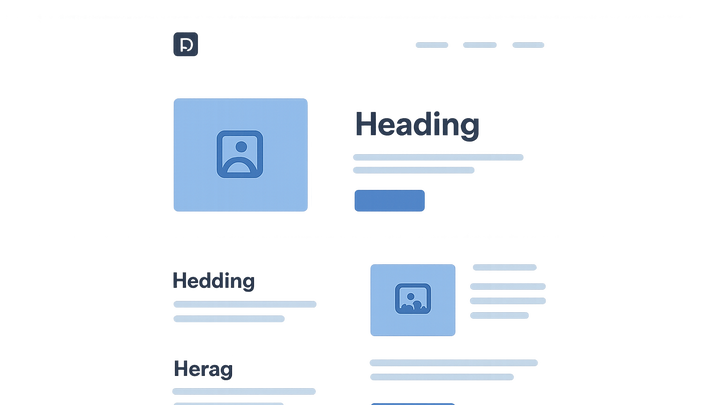Published on 2025-06-29T21:05:37Z
What is Page Layout? Examples and Best Practices
Page Layout refers to the arrangement of visual and interactive elements on a web page—headers, navigation, content sections, images, forms, and calls to action. A strategic layout balances aesthetics and functionality to guide users toward key actions, boost engagement, and increase conversions. It directly impacts Conversion Rate Optimization (CRO), shapes the User Experience (UX) by structuring information flow, and influences Search Engine Optimization (SEO) through semantic markup and content hierarchy. Tools like Prevue.me provide actionable critiques on your layout for CRO, lead generation, SEO, UX, and accessibility. By applying best practices—responsive grids, clear visual hierarchy, and prominent CTAs—you can craft pages that resonate with your audience and drive business goals.
Page layout
Arrangement of web page elements to optimize user flow, conversions, accessibility, and SEO performance.
Why Page Layout Matters in CRO, UX, and SEO
The layout of a page dictates how users interact with content and influences their perception and actions. Effective layouts can:
- Guide the eye through priority content
- Encourage clicks on primary CTAs
- Improve scan-ability for SEO crawlers
By aligning design with these factors, you create pages that appeal to both users and search engines.
-
Visual hierarchy
Organizing elements by size, color, and position to draw attention to key content and actions.
- Whitespace:
Using empty space around elements to reduce clutter and highlight important sections.
- Typography:
Selecting font sizes and weights to establish a clear reading order.
- Color contrast:
Applying color differences to make CTAs and headings stand out.
- Whitespace:
-
User attention flow
Layouts that align with natural reading patterns (e.g., F-pattern, Z-pattern) keep users engaged.
- F-pattern layout:
Places important content along the top and left, following common reading habits.
- Z-pattern layout:
Guides the eye in a zig-zag, suitable for simple pages with a single CTA.
- F-pattern layout:
-
Seo-friendly structure
Organizing headers and content improves crawlability and relevance signals.
- Header tags:
Using H1–H6 tags semantically to define content hierarchy.
- Content sections:
Segmenting text into well-labeled sections enhances both UX and SEO.
- Header tags:
Best Practices for Effective Page Layout
Adhering to established design principles ensures consistency, responsiveness, and clarity across devices.
Use these guidelines as a checklist when reviewing or creating layouts.
-
Responsive design
Ensures layouts adapt to various screen sizes for mobile and desktop users.
- Flexible grids:
Grid systems that adjust column widths based on viewport size.
- Media queries:
CSS rules that apply specific styles at different breakpoints.
- Flexible grids:
-
Consistent grid system
Maintains uniform spacing and alignment to create visual harmony.
- Modular spacing:
Using multiples of a base unit for margins and padding.
- Column alignment:
Aligning elements to grid columns for a clean structure.
- Modular spacing:
-
Clear call-to-actions
Designing prominent and compelling CTAs that stand out.
- Button contrast:
High-contrast buttons to attract clicks.
- Action-oriented copy:
Using verbs and benefit-driven language to prompt action.
- Button contrast:
Tools and Examples
Leverage specialized tools and design platforms to audit and refine your page layout.
-
Prevue.me
A SaaS platform offering actionable critiques on page layout for CRO, UX, SEO, accessibility, and lead generation.
- Cro audits:
Analyzes layout elements to improve conversion paths.
- Ux recommendations:
Suggests improvements for navigation and user flow.
- Seo analysis:
Evaluates structural elements for better crawlability.
- Accessibility checks:
Identifies issues in layout contrast and tab order.
- Lead generation tips:
Optimizes forms and CTAs for higher submission rates.
- Cro audits:
-
Figma
A collaborative design tool for creating and testing layouts in real-time.
- Component libraries:
Reusable elements for consistent design.
- Plugins:
Extensions for automated layout checks and accessibility scans.
- Component libraries:
-
Sample html structure
A basic semantic layout using HTML5 elements:
<div class="container"> <header>Hero Section</header> <main>Main Content Area</main> <aside>Sidebar / CTAs</aside> <footer>Footer Links</footer> </div>- Semantic tags:
Use
<header>,<main>,<aside>, and<footer>to define page regions. - Container class:
Wraps sections for consistent alignment and grid application.
- Semantic tags:
